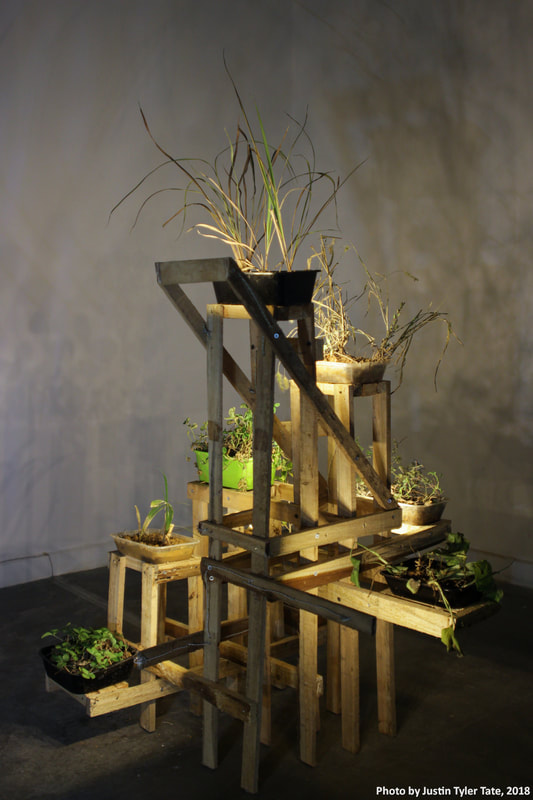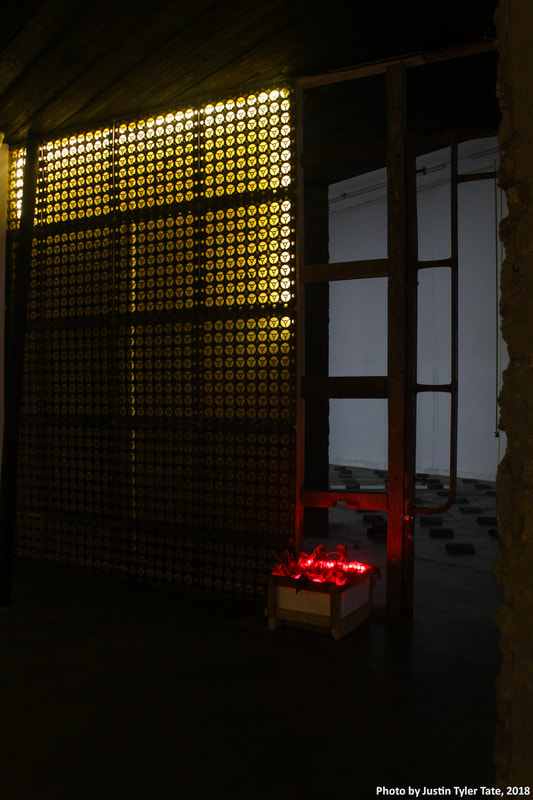|
The Cave
2018 Materials: Reclaimed wood, bamboo and steel, salvaged electronics, take out containers, and plants. 8m x 6.5m x 4m @ Advance Art Museum in Changsha, China |
The Cave is an installation which reinterprets Plato’s famous allegory of the same title. Using the narrative structure as a kind of scaffolding, the original story is in part retold through the visual elements of the installation, while simultaneously being modernized. The work takes the story’s theme centered on reality vs. the subjects’ awareness of it and extends that into critical questioning of our contemporary paradigm in relation to the materials and conveniences which surround us.
The installation does not hide any part of its construction nor does it shy away from the materials that went into its production – all aspects of the work are exposed and understandable – including that its materials are the Changsha city’s reclaimed waste such as take out containers, discarded electronics as well as abandoned building materials. In these points, the work reinterprets the original allegory by examining the the facade of contemporary conveniences juxtaposed with the reality of their consequences.
In the work’s utilization and modification of the existing architecture of the gallery space, The Cave becomes its own microenvironment with energy efficient light sources causing photosynthesis in the installation’s flora which then photoremediate the localized air. Fans mounted to the ceiling create moving air currents in the rooms, causing subtle changes to the installation’s plants – and in turn their shadows – while also causing the air to be cooler. Through the materials of the installation (wood, bamboo, steel, light and sound), the artist’s experience of Changsha City is reconveyed to viewers - that of unfinished construction projects, dimly lit spaces, take out containers, and incomprehensible audio.
Between the structure of the installation and the materiality of it, the work suggests a critique of unsustainable implementations of disposable technology and unrestricted urban growth, it advocates the use of detritus from such processes as possible solutions to 21st Century problems, while also curbing the utilization of new materials. The Cave transforms the white cube of the gallery, into a liminal space that is both representational and chimerical, realistic and optimistic, as well as dystopian and utopian.
The installation does not hide any part of its construction nor does it shy away from the materials that went into its production – all aspects of the work are exposed and understandable – including that its materials are the Changsha city’s reclaimed waste such as take out containers, discarded electronics as well as abandoned building materials. In these points, the work reinterprets the original allegory by examining the the facade of contemporary conveniences juxtaposed with the reality of their consequences.
In the work’s utilization and modification of the existing architecture of the gallery space, The Cave becomes its own microenvironment with energy efficient light sources causing photosynthesis in the installation’s flora which then photoremediate the localized air. Fans mounted to the ceiling create moving air currents in the rooms, causing subtle changes to the installation’s plants – and in turn their shadows – while also causing the air to be cooler. Through the materials of the installation (wood, bamboo, steel, light and sound), the artist’s experience of Changsha City is reconveyed to viewers - that of unfinished construction projects, dimly lit spaces, take out containers, and incomprehensible audio.
Between the structure of the installation and the materiality of it, the work suggests a critique of unsustainable implementations of disposable technology and unrestricted urban growth, it advocates the use of detritus from such processes as possible solutions to 21st Century problems, while also curbing the utilization of new materials. The Cave transforms the white cube of the gallery, into a liminal space that is both representational and chimerical, realistic and optimistic, as well as dystopian and utopian.
The Cave was designed and constructed by Justin Tyler Tate in Changsha, China for Advance Art Museum.












